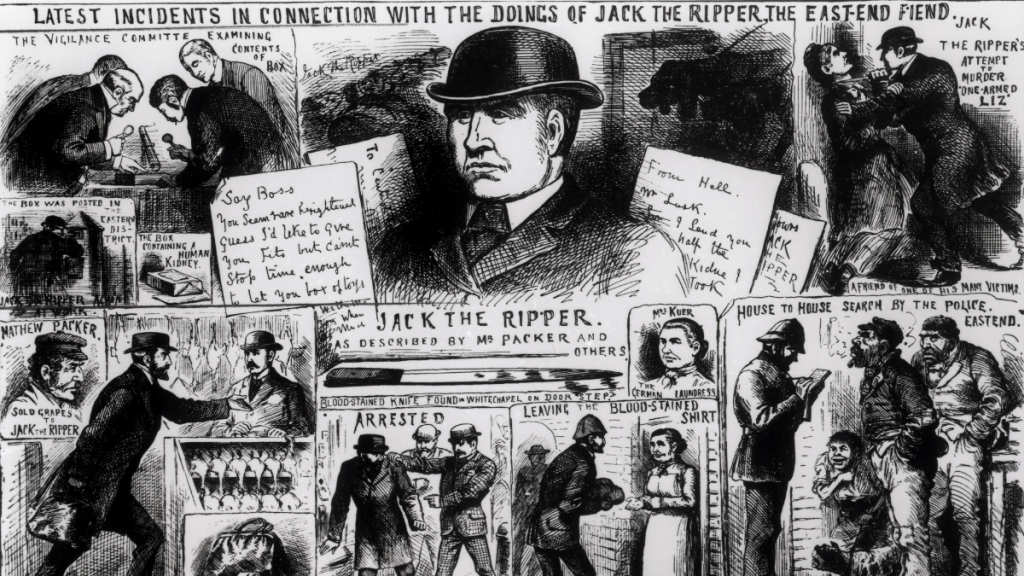Disclaimer: This article contains mentions of murder. Reader discretion is advised.
Unsolved Mysteries Volume 4 episode 1 revisits the crimes of Jack the Ripper, who authorities have never successfully identified. The first episode, “Who Was Jack the Ripper?,” looks back at 19th-century London, where the killer’s murders began.
He terrorized the streets of East End in 1888 and murdered five victims. People and experts believe Mary Jane Kelly was the fifth and final victim. Media outlets initially referred to the vicious killer as the Whitechapel Monster, among other monikers. They later began calling him Jack the Ripper based on a signature he used on a letter he allegedly wrote.
How did Jack the Ripper get his name?
According to Netflix Tudum, Jack the Ripper allegedly wrote a letter in September 1888. The killer signed it with his self-appointed moniker. The letter was sent to the Central News agency and remains one of the key pieces of evidence. Before that, media agencies had referred to the killer using names such as the Whitechapel Monster and Whitechapel Murderer, among other titles.
Jack the Ripper murdered his victims in the streets of East End in London. Historians believe the killer mainly targeted poor women who relied on sex work for lodging. These gruesome killings occurred between August and November 1888, and he murdered at least five women. The first murder victim was Mary Ann “Polly” Nichols, whom the killer had not only disemboweled but also slit her throat. Annie Chapman, Elizabeth Stride, and Catherine Eddowes were the next three victims. Experts believe the killer’s last known victim was Mary Jane Kelly.
Among all of Jack the Ripper’s victims, Mary Jane Kelly was the only one who was found dead in her bed. A common assumption was that all his victims were sex workers except for Kelly, reported Britannica. However, British social historian Hallie Rubenhold believes these women only resorted to solicitation in need of money. Rubenhold believed the victims were dubbed sex workers because of the Victorian era’s common misogyny and class-based prejudices.
Has Jack the Ripper been identified?
With limited resources and clues, detectives have never successfully identified Jack the Ripper. However, they did have a few potential suspects at the time, including one Montague John Druitt. Reportedly, Druitt was a barrister and teacher from South London who committed suicide in late 1888. He killed himself in the River Thames after claiming he was going mad. Druitt had also expressed how he wanted to end his life to avoid facing the repercussions of his actions.
Montague John Druitt’s family believed he was Jack the Ripper, but authorities could never link him to the murders of the victims. Moreover, there was a lack of eyewitnesses who could have placed him in Whitechapel when the murders occurred.
Authorities had also arrested Francis Tumblety, an American doctor who they suspected was Jack the Ripper. Tumblety would later explain how he traveled to Whitechapel after hearing about the murders. Another suspect was Aaron Kosminski, who was sent to a mental asylum in 1891. This could have backed the theory about why Jack the Ripper stopped killing after 1888. Kosminski turned out to be another dead end in the case.
Over the years, many films and TV shows have released Sir William Withey Gull, a royal doctor to be the real killer. Several theories claimed Gull got the task of murdering five women in an attempt to blackmail the crown. The theory has been debunked, as the alleged suspect suffered from a stroke a year before the killings began.
Jack the Ripper’s case remains unsolved today, and his crimes go down in history as some of the most foul murders. Now, Unsolved Mysteries Volume 4 on Netflix attempts to highlight the details of the infamous case.










